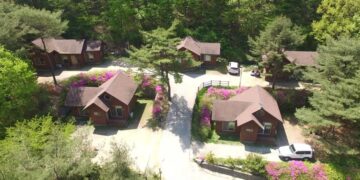Last Updated on 1 year by admin
Experience spring with golden canola flowers fields in Jeju. A paradise of vibrant blooms awaits between March-April. Dive into the beauty!
Jeju Island isn’t just a beautiful destination; it’s a haven easily reached through Jeju International Airport. Imagine – over 50 flight paths whisk you away from Japan, Southeast Asia, and Oceania, landing you right at the heart of paradise. But wait, there’s more! Come spring, between March and April, Jeju explodes in a vibrant spectacle. Forget the red carpets – Jeju rolls out a golden one, woven from fields of swaying canola flowers. Be it picturesque Sanbangsan Mountain or Seogwipo Gasiri Village, the gorgeous places on Jeju get covered with a yellow carpet full of canola flowers
Seogwipo Gasiri Village (Noksan-ro Canola Flower Road) (서귀포 가시리마을 (녹산로 유채꽃도로))
Forget the usual spring scenes. Seogwipo Gasiri Village on Jeju Island throws an entirely unique party every April. Imagine this: a 10-kilometer stretch along the village’s access road transforms into a breathtaking spectacle. Here, sunshine-yellow canola flowers erupt in a vibrant display, but that’s not all! Delicate light pink cherry blossoms join the party, creating a mesmerizing tapestry of color.
This stunning combination isn’t just a feast for the eyes; it’s a rare and delightful occurrence. Gasiri Noksan-ro Road, winding through the village, has earned its place as one of Korea’s “100 Beautiful Roads.” This scenic route wasn’t always a haven for flowers; it once traversed Noksanjang and Gammajang, prized horse farms during the Joseon Dynasty. Today, it’s a haven for photographers and flower enthusiasts alike, recognized as the “First Sight of the Ten Sights of Gasiri Village.”
But Jeju’s magic goes beyond the floral display. The landscape surrounding Gasiri boasts unique volcanic wonders – Ttarabioreum and Keunsaseumioreum Parasitic Cones. These fascinating geological formations add another layer of intrigue to your springtime adventure.
So, skip the usual spring destinations and discover the hidden gem of Seogwipo Gasiri Village. Embrace the explosion of color, explore the historic route, and marvel at Jeju’s enchanting volcanic landscape. It’s a springtime experience unlike any other.
Sanbangsan Mountain (산방산)
Sanbangsan Mountain on Jeju Island isn’t your typical mountain. This majestic peak is a sleeping giant, born from a fiery eruption 700,000 to 800,000 years ago. Imagine a colossal mass of lava solidifying into the impressive dome we see today. The testament to its fiery past lies on the southern cliffs. Here, weathering has carved out a mesmerizing display of pits and scree slopes, some reaching a staggering 200 meters!
True to its name, “Sanbangsan” translates to “mountain with a cave inside.” Nestled about 150 meters above the sea, this grotto offers breathtaking ocean views. The mountain’s proximity to the coast and its height often paint the peak with a mystical cloak of clouds. But the magic doesn’t stop there. The upper slopes boast unique microclimates, making them a haven for fascinating plant life – a paradise for botanical enthusiasts.
A journey up Sanbangsan Mountain is a walk through history and spirituality. The slopes are graced by the presence of Sanbangsa Temple and Bomunsa Temple, the latter housing sacred Buddhist relics. Wander between these temples along the ancient stone steps and discover the hidden gem of Sanbanggulsa Grotto.
At the foot of the mountain, a silent sentinel stands guard – the Yeondae signal beacon. Similar to the more famous Bongsudae beacons, Yeondae played a crucial role in communication. Built on coastal hillsides like Sanbangsan, Yeondae relayed urgent messages using smoke by day and fire by night.
So, if you seek an adventure that blends volcanic wonder, spiritual serenity, and historical intrigue, look no further than Sanbangsan Mountain. It’s a Jeju Island experience that will leave you breathless.
From picturesque landscapes to hidden gems and cultural adventures, follow KoreaTravelPost’s Twitter, Facebook, Instagram, LinkedIn, and Flipboard for a thrilling journey through the heart of Korea.
Related Posts
4,962 total views, 1 views today



















